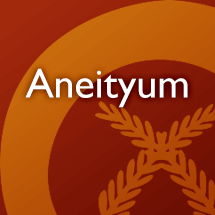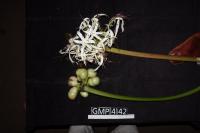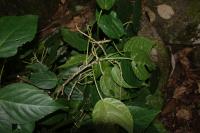Your search for * in medicine / other has returned 30 entries
incatyatou
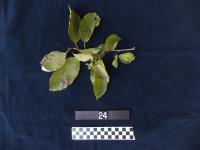
n. tree. Acting as a fence post. (collection: Ashley A McGuigan #24)
Example: 1. For vomiting/uneasyness - remove the bark of a stem and take the inner bark (this should be white). Smash the white bark with about 150ml of cold water and drink. The bark can also be boiled and cooled down to drink cold. Believes when you vomit a lot this will restore your body and give you energy again. Take after vomiting but can use even when not sick. 2. For stomache ache - Can also be prepare and taken as in part 1. 3. For painful urination, also prepared as in part 1. 4. The fruits are sticky and used as a type of local “glue.” Collect the fruits when ripe, hold the outside of the fruit in the hand, and put the end of the fruit that has the sticky sap on paper or anything else needing to be glued. In ancient times, this sticky glue helped join the strings together that were used to make a long fishing line. 5. In ancient times this sticky glue helped join the strings together when making a long one for fishing. 6. During the heat of the day, in the hot season, take inner bark from 1 stick, scrape bark into 1 liter water and drink all day to help prevent a person from getting urinary infection, resulting in painful urination from being in the sun too much. 7. If you put the leaves of this plant in a bag with your fishing gear – it will help catch a lot of fish – magic. 8. Cut a 1-2 m long branch in each of 4 corners of the garden which is a rectangle, place it in an “X” at each corner, this will cleanse people who have not been cleansed who come in the garden. 9. If a person is not cleansed e.g. has not fasted from certain foods, the crops will not bear good fruits. So when gardening, people believe it is best not to eat coconut, shellfish, fish, stay away from sex, and no fermented food like breadfruit and bananas, OR if you have a visitor overnight and then you heal to cleanse yourself before going to the garden. After a woman finishes her period, she will stay out of garden for 10 days, this is specifically for kava, water taro, sugarcane and yam in the garden. Other crops – cassava, sweet potato, and taro Fiji are okay. Different Kastom for N, S, W, E people – so this Kastom is for South and Eastern people.
bookmarkintijgancedo
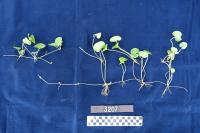
n. prostrate herb growing on ground in open or partly shaded area next to banana tree. (collection: Gregory M. Plunkett #3207)
Example: 1. The plant is named after a "rat"s ear.’ Eat 4 fresh leaves every morning to clear the brain and help remember things. 2. This plant is an indicator of rich soil--a good place for growing vegetables. 3. Very useful plant, food and medicine. Name means rat ear. Take 5 leaves, wrap in INROWOD (Cordyline fruticosa) and cook for 15 minutes, remove it hot (be sure you do not burn it) squeeze out 1 tablespoon and give to baby to drink to treat a flu. 1x morning for 5 days.
bookmarkintoutau
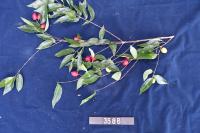
n. tree, 14 m tall (collection: Gregory M. Plunkett #3586)
Example: To make a fire, take a 1-2 cm diameter stick, sharpen it and rub it against a larger piece, ca. 6 cm in diameter. As a person rubs, the stick will start smoking and then start a fire, especially if there are a few small slivers of stem on the stick that can catch fire. People use other types of sticks to rub against the larger piece as well, and this will make a fire.
bookmarkintoutau
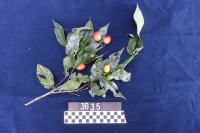
n. tree, 7-8 m tall (collection: Gregory M. Plunkett #3635)
Example: The wood from this tree is used for house posts. Used to heal bad spirits, headaches, fever, or any other kind of illness that modern medicine cannot fix. Must be taken and performed in the evening before the sun sets. Take four leaves from the top of the intoutau, netethae, nelmaha, inrowod plants. Combine them with 1/4 cup of water and squeeze the juice out of the leaves and pour into a piece of bamboo. Give the mixture to the sick person to drink. The woman must drink half of the mixture and use the other half of the mixture to wash their body with. The woman then has to stay away from other people except for those who helped wash her. Then you must smash the bamboo that contained the mixture where the sun sets.
bookmarkinyehec
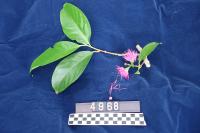
n. tree to 7 m, dbh 20 cm (collection: Michael J. Balick #4968)
Example: The fruits are edible when they are red. If a person has been drinking kava and the next morning feels hung over, they can take a handful of the leaves of this plant, crush them in cool water, and wash their face with this. This treatment will help the kava feeling to disappear. At the same time, if a person eats the fruit of this tree a few hours in advance of planning to drink kava, they cannot drink kava as it will reduce the effects of the kava. The trunk of this tree can be used to build temporary houses and also it is good for firewood. When the plant is in flower, flying foxes and birds come to drink the nectar and hunters know this so they hunt near this tree.
bookmarkmako amyiñ
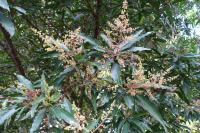
n. tree to 5 m, fdby 35 cm (collection: Michael J. Balick #4979)
Example: The fruits are edible and ripen during November-December. The leaves can be boiled as a medicine. If a person has a hoarse voice, boil 4 or or a few more leaves in 1 liter of water. Cool the mixture and drink once daily until the voice returns to normal. The trunk of this tree is good for timber, as it is a very hard wood. But a productive tree is not cut for timber--only the wild mangos that have flowers and small fruits that do not ripen; these trees are cut for timber. This particular tree, "Mango Amgie" bears fruit with a great deal of fiber, so the name refers to the "mango that you drink." Amgie means "drink" in the Aneityum language. There is another variety of mango, "Mango Cig" that means the mango that you eat. It has a little fiber but good fleshy fruits. This species is introduced from outside of Aneityum.
bookmarknaha
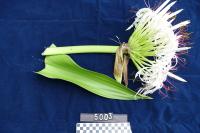
n. herb to 1 m, flowers white (collection: Michael J. Balick #5003)
Example: The leaves are used to wrap fish for cooking in an open fire. If you eat a bad fish and begin to feel the effects of it a few hours later, such as with Ciguatera illness, cut the base of the stem of this plant and let the sap drip into a half coconut shell with coconut water in it, drink the shell and it will make the person vomit out the bad food. It does not taste good but is very effective in making a person vomit as it contains a toxic compound.
bookmarknajañ
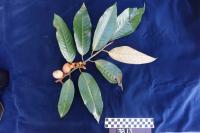
najeng
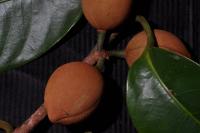
n. tree, 8-10 m tall (collection: Gregory M. Plunkett #4017)
Example: 1. Aerial roots have a natural curve that allows them to be used as a clothing hanger. The outer bark is peeled and dried all day in the sun, before the roots are used. 2. Leaves are used to help remove fish bones lodged in one’s throat. When bones are stuck in one’s throat, then you apply young leaves to the outside of the throat. Apply once and leave until the bones are removed.
bookmarknala
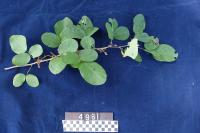
n. shrub to 2 m, coastal vegetation (collection: Michael J. Balick #4961)
Example: The stem of this plant is used for firewood. If a person has been drinking kava and the next morning feels hung over, they can take a handful of the leaves of this plant, crush them in cool water, and wash their face with this. This treatment will help the kava feeling to disappear.
bookmarknala
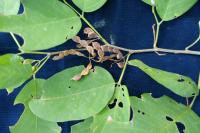
n. tree to 7 m, dbh 20 cm (collection: Michael J. Balick #4860)
Example: This is a common tree. If a person travels from one district to another on Aneityum, and you see the tree planted in that other district, a person knows they are free to come into this area. When the leaves are yellow, as in a young tree, the local name is nala’gay. If a person carries a branch of this tree into a village it is a symbol that the person is coming with peaceful intentions.
bookmarknala
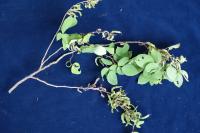
nala
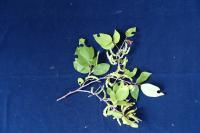
nala
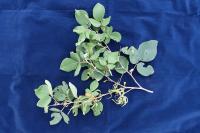
n. shrub, 1. 5 m tall (collection: Gregory M. Plunkett #3217)
Example: 1a. When traveling past a community you can place these leaves in a basket or walk with it in your hand. In this way people in the community know that you are traveling in peace and will cause no harm to people in that village. 1b. Message plant – if you go to visit someone and they are not there, you leave a branch of this on the door or somewhere they can see it and they know that some relatives have come and tried to visit them.
bookmarknanad
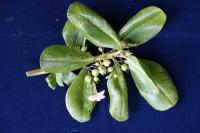
n. shrub, 1 m tall (collection: Gregory M. Plunkett #3553)
Example: 1. A stimulant plant. If a person is going to their garden early in the morning before the sun come up, break 2 top young leaves and chew and swallow the liquid, spitting out the fiber. This makes the person able to work harder and not feel tired while in the fields. It was noted that "a person can do the work of many people if they chew this." 2. The leaves are used for fertilizer for taro--put a bunch of leaves in a hole were taro is to be planted as a compost/antibiotic. This practice is said to kill all of the bad organisms such as bacttively impact the health of the taro plant. 3. This one collected from coastal area, ?? one collected in forest area. People take 4 leaves, chew leaves, swallow juice, gives energy to work hard the entire day. For fishing, take lots of ripe fruits and put in pocket, you will be able to catch a lot of fish. It brings good fortune when fishing. Roots – take one root, wash where a woman is giving birth to a newborn baby, give a drop of the juice from the root to clear the mucus in the throat.
bookmarknanad
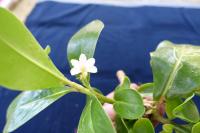
nanad
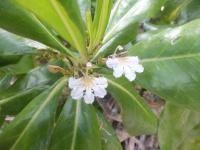
n. shrub. Growing near the beach. (collection: Ashley A McGuigan #4)
Example: 1. Dried branches from this plant can be used to roast vegetable crops that women eat if they have problems becoming pregnant. 2. Firewood, burns well. 3. Some people will eat the green fruit for protection against black magic. Eat 5 fruits for this. Eat it only once – will last for a year.
bookmarknanad cop̃ou
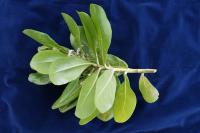
n. small shrub, 0. 5 m tall (collection: Gregory M. Plunkett #3219)
Example: 1. A stimulant plant. If a person is going to their garden early in the morning before the sun come up, break 2 top young leaves and chew and swallow the liquid, spitting out the fiber. This makes the person able to work harder and not feel tired while in the fields. It was noted that "a person can do the work of many people if they chew this." 2. The leaves are used for fertilizer for taro--put a bunch of leaves in a hole were taro is to be planted as a compost/antibiotic. This practice is said to kill all of the bad organisms such as bacttively impact the health of the taro plant. 3. This species is collected in the coastal areas, and is different from the one that looks similar to it, that grows in the forested areas. People take 4 leaves, chew leaves, swallow juice, gives energy to work hard the entire day. For fishing, take lots of ripe fruits and put in pocket, you will be able to catch a lot of fish. It brings good fortune when fishing. Roots – take one root, wash where a woman is giving birth to a newborn baby, give a drop of the juice from the root to clear the mucus in the throat.
bookmarknawa
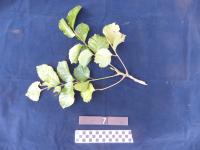
n. shrub. Village pathways. ornamental. (collection: Ashley A McGuigan #7)
Example: 1. Heat the leaves then place on the sore muscle. 2. Edible plant, cook young leaves until soft and then can eat, as a vegetable or soup, with any food. 3. Same use as AAM 3 to heat and put on body to heal pain. 4. On a reef when it is time to protect the reef to conserve it and bring more fish, you take this plant and put it in the hole in the reef – cut stem and put it in reef in several parts. People will know it is under protection and respect it.
bookmarknecjop̃dak
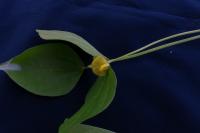
n. low-growing, creeping vine growing in grassy area just inland from coastal strand. Flowers yellow. (collection: Gregory M. Plunkett #3223)
Example: The leaves of this plant are used to treat stomach ache. Take a handful of leaves and mix with 1/2 liter of water, crush the leaves in the water and drink the entire amount when your stomach hurts. Alternatively, this can also be consumed 1x a week as a tonic drink for the stomach and system.
bookmarknecjop̃dak
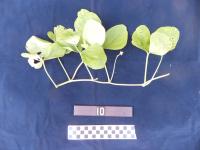
n. prostrate creeping vine along coastlines. (collection: Ashley A McGuigan #10)
Example: 1. To cure rubbush blood - Take a handfull f leaves of any age, pound it into a cupfull of water, squeeze the juice and drink when woman feels pain in head or inside the body or when the inside of the body is hot. Drink this once a day until the pain goes away. 2. To cure excessive bleeding after giving birth - boil naojapdak leaves (2-16) in seawater until leaves are soft and the water is brown. Sit on this water. 3. To close the cervix - boil 2 naojapdak leaves in water and bath in it. 4. Medicine: Smash leaves 1 handful, into cup and add a small amount of water to treat constipation—1 cup for children; 1.5 litres for adults. 5. Stomachache: same treatment, will clear bowel. 6. For leg sores, collect whole plant, put in water – a pool of water for 1 week, then use to dip sore as on leg into it for 10-15 minutes cure the sore.
bookmarknecñopod
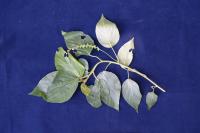
n. shrub, 1 m tall (collection: Gregory M. Plunkett #3512)
Example: This plant is used as fertilzer to place on bottom of the taro patch in the same way as GMP #3456 to help "feed the ground" for next year. The leaves are used to wrap food. When a person is chewing kava, pile the chewed kava roots on the young leaves of this species. Also, an unspecified medicinal use.
bookmarknecñopod
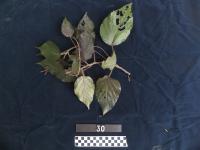
necñopod cap
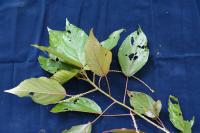
n. shrub to 2. 5 m tall, 1 cm dbh (collection: Michael J. Balick #4856)
Example: When a person gets burned by a fire, take the leaves, squeeze sap on the burn, and then rub a handful of leaves on the burn; use a larger amount of leaves if the person has a larger burn. Apply it directly after the person is burned. This treatment will stop the burn from blistering. Use once. When a 1 month to 2 year old baby has redness or sores on their tongue and cannot eat properly, and saliva is coming out from their mouth, take the sap of the crushed leaves in a spoon and give it to the baby. Take one teaspoon for a 1-5 month old child and a tablespoon for a 6-24 month old. Give the baby once a day for 2 days. This treatment cleanses out the reddish sores. If a person has a sore that is persistent and stays red and sore for a week or more, take 4 apices of this plant, chew and spit on the sore to help it heal. Use 1x in the morning, and next day in the afternoon. Use 2x only. If a person is walking in the bush and concerned about evil spirits, put a small branch behind the ear to be safe. To treat hot chest pain, dizziness, shortage of breath, and if a person has a hot pain that does not go away after taking panadol (aspirin), take 8 leaves and squeeze into a glass of water until it turns reddish, drink 1x a day for 3 days; this is said to make the pain go away.
bookmarknilpodon
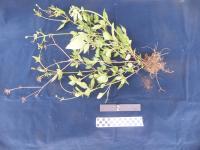
n. herb. Growing along village path. (collection: Ashley A McGuigan #2)
Example: 1. Take handful of young leaves from the middle of the branch and rub until soft. Squeeze the leaves into a cup to get the juice. This will help with a stomache ache for any woman, but especially women who have been fed a potion. 2. To stop baby crying - take 8 fresh leaves and squeeze into warm water. Medicine, wash the plant, take either the leaves or whole plant, 1 handful of leaves, boil in 1 liter water for a few minutes, let it cool, drink 1 cup 1x day for 3 days, flu, headache, stomachache. Considered a weed that likes to grow in cultivated areas.
bookmarknilpodou
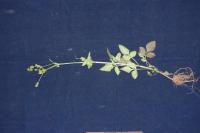
n. herb, growing at edge of garden area. Flowers yellow. (collection: Gregory M. Plunkett #3599)
Example: This is for a medicinal tea to give energy to a person who is not feeling well. Collect a handful of young stem apices and boil in 2-3 cups of water. Drink warm to help the body be strong and healthy. It is also good to treat diarrhea. When a person feels well again, stop this treatment but they can also drink this 1x daily, once before breakfast or before lunch, as a healthful tea.
bookmarknilpudou
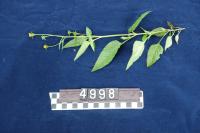
n. herb to 70 cm, florets yellow (collection: Michael J. Balick #4998)
Example: To treat a headache, especially from the flu, boil a handful of leaves in 1 liter of water for a few minutes, let cool and drink 1 cup of liquid per day . Also can treat this type of headache by using the plant in a steam bath, by boiling 4 handfuls of leaves in a pot of water, covering the head with a towel and breathing in the steam from the pot.
bookmarknilpudou
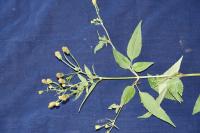
n. herb to 50 cm, flowers yellow. (collection: Michael J. Balick #4944)
Example: As a tonic medicine, collect a full handful of leaves, boil in one liter of water until fully cooked, then drink 1 cup 3x daily, warm, to treat a person who has worked too much, who is tired, to help their stomach and to help make them strong. For children and adults. Child’s dose is 1/2 cup, 3x daily until the child feels stronger.
bookmark